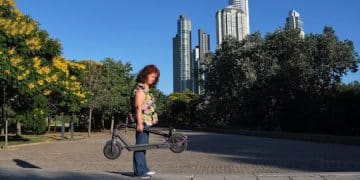Green Commute: 5 Eco Hacks Saving Americans $500 Yearly

Green your commute by adopting eco-friendly transportation alternatives such as biking, public transit, carpooling, electric vehicles, and optimized driving habits helping Americans save up to $500 annually while reducing their carbon footprint and contributing to a more sustainable environment.
Is your daily commute draining your wallet and harming the planet? It doesn’t have to be! By implementing a few simple changes, you can green your commute: 5 eco-friendly transportation hacks saving Americans $500 annually, reduce your carbon footprint, and keep more money in your pocket. Keep reading to discover how!
Embrace Eco-Friendly Transportation
The concept of eco-friendly transportation revolves around minimizing the environmental impact of our daily journeys. From reducing greenhouse gas emissions to conserving natural resources, the benefits are far-reaching. But where do you begin?
Adopting greener commuting habits can significantly reduce your carbon footprint and contribute to a healthier environment. Let’s delve into some practical strategies you can implement today.
Understanding the Environmental Impact of Commuting
Traditional commuting methods, such as driving alone in gasoline-powered cars, contribute significantly to air pollution and greenhouse gas emissions. These emissions lead to climate change and respiratory problems. Embracing eco-friendly alternatives can mitigate these harmful effects.
The Financial Benefits of Green Commuting
Beyond the environmental advantages, adopting eco-friendly commuting options can lead to substantial financial savings. From reduced fuel costs to lower maintenance expenses, the financial perks are undeniable. This allows you to reallocate funds to other essential aspects of your life.
- Reduced fuel costs by switching to cycling or public transport.
- Lower maintenance expenses with electric vehicles.
- Tax incentives for using alternative transportation methods.
- Savings on parking fees by carpooling or using public transport.
By embracing eco-friendly transportation, you not only contribute to a cleaner environment but also enhance your financial well-being. Let’s explore specific strategies you can adopt to transform your commute.

Hack 1: Cycle to Work for Fitness and Savings
Cycling to work is a fantastic way to combine your daily commute with exercise, promoting both physical and environmental health. It’s a simple yet effective step towards a greener lifestyle.
Switching to cycling can bring significant savings through reduced fuel consumption and gym memberships. Here’s how you can make the most of this eco-friendly transportation hack.
Essential Gear for a Safe Cycling Commute
Safety should be a top priority when cycling to work. Investing in essential gear ensures a secure and enjoyable commute. Key items include a helmet, reflective clothing, and bike lights.
Planning Your Cycling Route
A well-planned cycling route can make your commute safer and more efficient. Look for bike lanes, paths, and quieter streets to minimize traffic exposure. Familiarize yourself with the route before your first ride.
- Use online mapping tools to identify bike-friendly routes.
- Consider distance and elevation changes for a comfortable ride.
- Check for bike repair stations along your route.
- Practice the route on a weekend to get comfortable.
Cycling to work is more than just a commute; it’s a lifestyle choice that benefits both your health and the environment. With the right preparation and planning, you can enjoy a safe and cost-effective way to get to work.
Hack 2: Embrace Public Transportation
Public transportation is a cornerstone of sustainable commuting, offering a reliable and eco-friendly alternative to driving. By utilizing buses, trains, and subways, you can reduce your carbon footprint significantly.
Public transportation is not only environmentally responsible but also economically advantageous, especially in urban areas. Let’s explore how to make the most of public transport for your daily commute.
Advantages of Public Transportation
Public transportation offers a multitude of benefits, from reducing traffic congestion to lowering emissions. Utilizing public transport can save you money on fuel, parking, and vehicle maintenance.
Navigating the Public Transportation System
Understanding how to navigate the public transportation system is key to a smooth and efficient commute. Learn about routes, schedules, and fare options to optimize your journey.
- Utilize mobile apps for real-time schedules and route planning.
- Explore monthly or annual passes for cost savings.
- Familiarize yourself with different modes of transport available in your area.
- Plan your route during off-peak hours for a more comfortable ride.

Choosing public transportation is a conscious step towards a greener and more sustainable lifestyle. It not only benefits the environment but also offers a relaxing and cost-effective way to commute.
Hack 3: Carpool and Share the Ride
Carpooling is a practical and social way to reduce traffic congestion and emissions. Sharing a ride with colleagues or neighbors can significantly decrease the number of cars on the road.
Carpooling provides both economic and environmental benefits, from lowering fuel costs to reducing wear and tear on your vehicle. Consider these strategies to make carpooling work for you.
Finding Carpool Partners
Identifying suitable carpool partners is crucial for a successful carpooling arrangement. Look for colleagues or neighbors who live nearby and have similar work schedules.
Establishing Ground Rules for Carpooling
Setting clear ground rules ensures a smooth and equitable carpooling experience. Discuss schedules, pick-up locations, and cost-sharing arrangements to avoid misunderstandings.
Consider the following to improve carpooling
- Create a roster of carpoolers to take turns driving.
- Use carpool apps to coordinate rides and track expenses.
- Establish clear payment terms for fuel and maintenance.
- Alternating drivers on a weekly or monthly basis.
Carpooling not only helps the environment but also fosters a sense of community among participants. By sharing the ride, you contribute to a more sustainable and connected society.
Hack 4: Consider Electric Vehicles (EVs)
Electric vehicles (EVs) represent a significant advancement in eco-friendly transportation, offering zero tailpipe emissions and reduced reliance on fossil fuels. EVs are becoming increasingly accessible and affordable, making them a viable option for many commuters.
Switching to an EV can bring long-term financial benefits, including lower fuel and maintenance costs, as well as eligibility for tax incentives. Explore the possibilities of electric vehicles and how they can transform your commute.
The Benefits of Electric Vehicles
Electric vehicles offer numerous advantages over traditional gasoline-powered cars. From zero tailpipe emissions to lower running costs, EVs are an environmentally and economically sound choice.
Charging Your Electric Vehicle
Understanding how to charge your EV is essential for a hassle-free driving experience. Explore various charging options, from home charging stations to public charging networks.
- Install a home charging station for convenient overnight charging.
- Utilize public charging stations at work or along your commute.
- Look for fast-charging stations for quick top-ups during long trips.
- Consider the charging infrastructure available in your area.
Investing in an electric vehicle is a significant step toward reducing your carbon footprint and promoting sustainable transportation. With advancements in technology and infrastructure, EVs are becoming a mainstream choice for environmentally conscious commuters.
Hack 5: Optimize Driving Habits
Optimizing your driving habits can significantly reduce fuel consumption and emissions, even if you’re not ready to switch to alternative transportation methods just yet. Small changes in your driving behavior can have a big impact.
Adopting eco-friendly driving techniques not only benefits the environment but also saves you money at the pump. Explore these practical tips to make your driving more efficient.
Eco-Friendly Driving Techniques
Implementing eco-friendly driving techniques can lead to significant fuel savings. Avoid aggressive acceleration, maintain a steady speed, and anticipate traffic flow to minimize braking.
Maintaining Your Vehicle for Optimal Efficiency
Regular vehicle maintenance is crucial for optimal fuel efficiency. Keep your tires properly inflated, change your oil regularly, and ensure your engine is running smoothly.
You can also make some considerations to improve your driving habits:
- Avoid idling for extended periods.
- Combine errands into a single trip to reduce mileage.
- Remove unnecessary weight from your vehicle.
- Use cruise control on highways to maintain a consistent speed.
By adopting eco-friendly driving habits and maintaining your vehicle properly, you can reduce your environmental impact and save money on fuel. These small changes can make a big difference in promoting sustainable transportation.
| Key Benefit | Brief Description |
|---|---|
| 🚲 Go Green | Opt for cycling to work to merge fitness with environmental consciousness. |
| 🚌 Public Transit | Utilize public transportation to cut emissions & save on fuel. |
| 🤝 Carpool | Share rides with colleagues or neighbors to minimize traffic. |
| ⚡ Electric Vehicles | Consider EVs for zero emissions and reduced running costs. |
Frequently Asked Questions
▼
Savings vary, but cycling, carpooling, and public transit can save hundreds annually on fuel, maintenance, and parking costs, potentially reaching $500 or more.
▼
Yes, many regions offer tax credits or incentives for purchasing electric vehicles or using public transportation. Check your local and federal guidelines for eligibility.
▼
Advocate for workplace initiatives like bike storage, EV charging stations, or carpool programs. Highlight the benefits to both employees and the environment.
▼
Establish clear communication and guidelines. Rotate driving duties, share music or podcasts, and be respectful of each other’s time and preferences.
▼
Wear a helmet, reflective clothing, and use bike lights, especially at dawn or dusk. Plan your route in advance and follow traffic rules to ensure a safe commute.
Conclusion
By embracing these five practical hacks, you can transform your commute into an eco-friendly and cost-effective experience. From cycling and public transport to carpooling and EVs, there are numerous ways to reduce your carbon footprint and save money, contributing to a healthier planet and a brighter financial future. Start making these changes today and enjoy the benefits of a greener commute!





